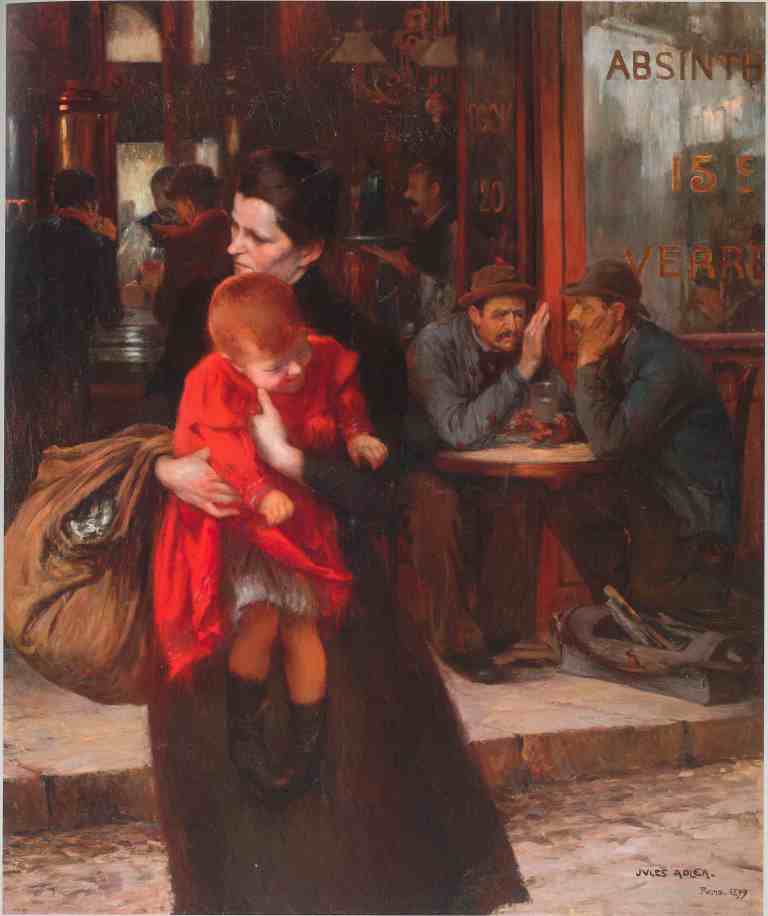Description:
Jules Adler (1865-1952) studied at the Paris École des Arts Décoratifs, later the Académie Julian. He painted landscapes, and was best known for his realistic scenes of Parisian workers and steelworkers from Creusot, as well as fishermen and peasants from Brittany. His work was characterized by a nearly naturalistic reportage and photographic frames showing the hardships of the poorer social classes. He was a member of the Société des Artistes Francais, a member of its Committee and Jury, a Knight of the Legion of Honor, and a founding member of the Salon d’Automne.
Description of the painting:
The painting appears to be a photographic snapshot of a random street scene. The mother, almost running, holds the child to her breast while also holding a large bundle. The background is filled with a bar full of men drinking. The whole is kept in monochrome, dark colors, only the red dress of the child stands out in the composition. The painting “Mother” should be compared to the similarly located, on the other side of the passage to the next room, the painting “Evening After the Storm” by É.A. Wéry.
Two paintings by two different members of the “Black Band” in the Rogalińska Gallery are in the same room, even hung on the same wall. Both depict a mother holding a child, but in a very contrasting way. The canvases were highly rated by critics and chosen for the retrospective Universal Exhibition in Paris in 1900.
Jules Adler was a realist painter. In addition to depictions of Brittany, he showed almost reportage relations with the everyday life of the working class and snapshots of scenes from French streets. The composition of the painting entitled “Mother” recalls a photographic frame. It seems to be a random shot of the moment of the action taking place in the city space. The title mother with a child in her arms and a large package quickly crosses the street. Behind her, in the background, crowded in a bar, men drink absinthe. The canvas dominates brown, monochromatic colors. Against it stands out the brighter figure of a child, as the one whose dust, grayness and the rush of urban life has not yet been dominated.
The author of “Evening after the Storm” gained the greatest fame for his naturalistic representations of Breton topics. His fondness for the themes of everyday life of the inhabitants of the peninsula was born in É.A. Wérym during one of his trips to Brittany in the company of his friend, fowist Henri Matisse. On the presented painting, in the foreground a mother with a child in her arms is shown. The canvas, like the discussed “Mother” by Adler, is kept in a dark color scheme. Attention is drawn to the distinctive, light face of the woman. She looks at her child with an expression of concern, fatigue, and perhaps resignation. Her melancholic face is in harmony with the surrounding scenery: cloudy sky, lonely, crowded in a port boats abandoned by fishermen returning after dangerous and probably unsuccessful fishing trips home. Perhaps the mother with the newly born child, as soon as the storm subsided, went out to see if her husband had returned.
Two paintings, two women, two worlds. On the one hand a poor working woman, in a hurry through the streets of a crowded city, on the other – a mother plunged into melancholy, routine, living on the edge of Brittany, in a poor fishing village by the ocean. The contrast of two different scenes evokes reflections on the style of life, its urban tempo, the fight with the difficult everyday life and the all-encompassing nature, to which the inhabitants of the fishing village completely subordinated, accepting the order imposed by it.


